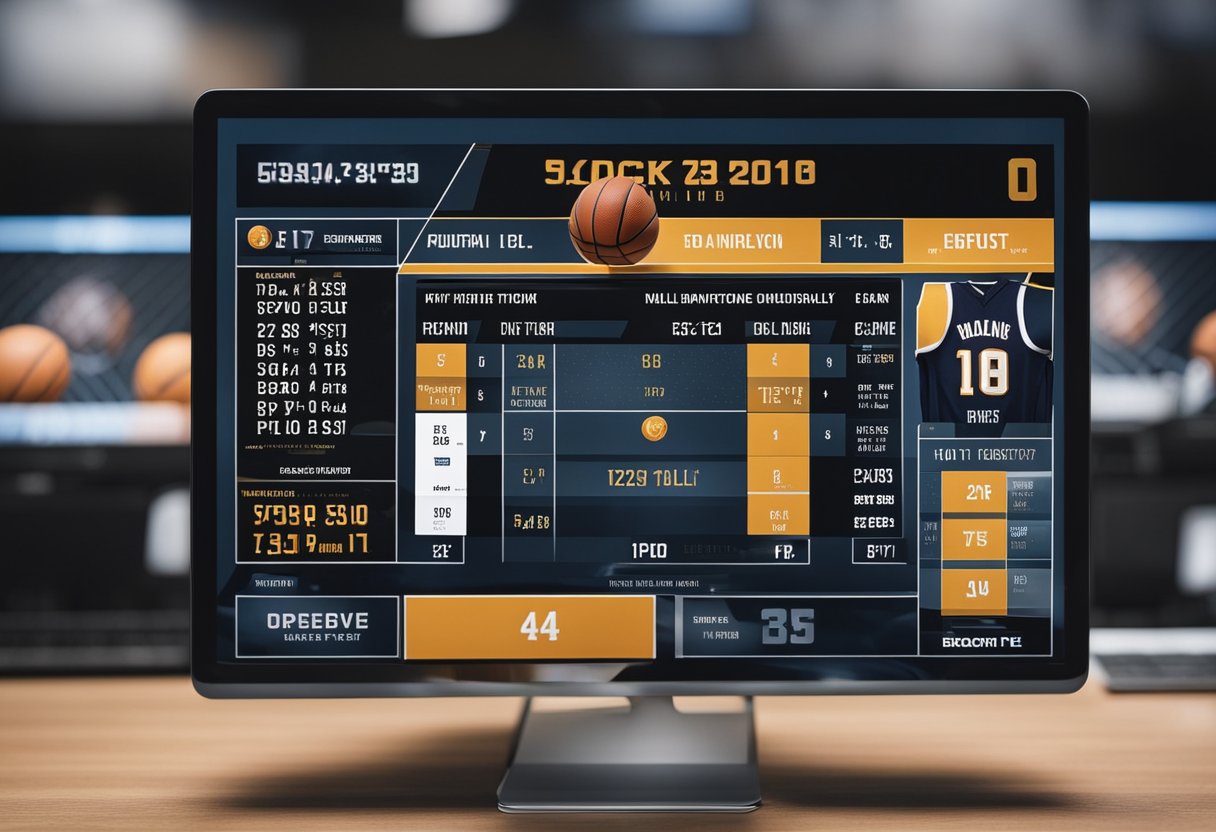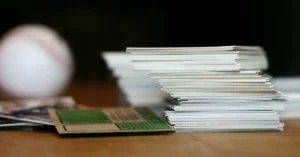Step into the world of basketball memorabilia with my comprehensive guide on how to make a basketball card.
As an expert in the field, I’ll walk you through choosing the right design and ensuring print perfection, so you can craft a standout card that any collector would cherish.
How to Make a Basketball Card: Getting Started

Creating your own basketball card can be a fun project whether you’re a fan, a player, or a collector. First, you’ll need to decide on the size and materials for your card. The standard trading card size is 2.5″ x 3.5″, but you can choose other dimensions that fit your vision.
- Materials:
- Cardstock: This is a popular choice for a traditional feel.
- Plastic: A more durable option that gives the card a professional look.
Next, select a template or design your layout. A template can simplify the design process and ensure your card has a balanced and organized appearance.
- Design Tips:
- Choose clear images and legible font types.
- Include stats or interesting facts on the back.
- Balance the design with space for text and visuals.
Finally, gather your materials. Quality cardstock can be bought from arts and craft stores, while plastic sleeves are available at collectible shops or online to protect your finished cards. Once you have your materials, template, and design ideas ready, you’re all set to create your basketball card. Make sure to let your creativity shine and have fun with the process!
Designing Your Basketball Card

Creating a basketball card involves combining personal creativity and understanding design principles to construct a memorable and professional-looking card. Remember the card’s layout, thematic direction, and visual appeal as you embark on this creative endeavor.
Choosing a Layout and Theme
Select a basketball card template that resonates with your vision for the card. Whether you’re making a traditional card or looking for something unique, the layout sets the base of your design. Next, choose a theme that reflects the player’s identity or team spirit.
This can be a color scheme from the team’s jersey or a graphic style that matches the player’s energy. For example, a high-energy theme with bold colors might be suitable if your player is known for dynamic plays. Make sure the theme you select is customizable to allow for personal touches.
Adding Player Information
Player information is crucial for a basketball card. Your layout should include the player’s name, team name, stats, and a short bio. When adding the stats, arrange them clearly and concisely. You could use a table format to display season averages or career highlights, making it easy to read at a glance. The bio section doesn’t need to be lengthy—a few sentences capturing the player’s background or career achievements will suffice.
Incorporating Visual Elements
The visual appeal of your basketball card largely depends on the images you use. Typically, action shots make a card more dynamic, but ensure the picture quality is high and the subject is adequately cropped to focus on the player. If you’re using multiple images, maintain a consistent color palette across them to unify the card’s design.
The card’s background should complement and not overpower the player’s image. If you want to highlight the player further, you can experiment with subtle graphic elements that don’t distract from the main image.
Printing and Laminating Your Card

Once you’ve finalized your basketball card design, the following steps are printing and laminating. These stages are crucial to your card’s look, feel, and longevity. You must consider the print quality and the materials you’ll use to ensure your card stands tall in a collection.
Selecting Printing Options
When choosing printing options, focus on the quality of the cardstock. For a standard card, 2.5″ x 3.5″ is typically used. Heavier cardstock gives your card a professional feel. Opt for a luster or glossy finish to make the colors pop.
- Dimensions: Stick with standard sizes for universal compatibility with card sleeves and holders.
- Cardstock: 14pt or 16pt cardstock is ideal.
- Finish: Matte, luster, or glossy.
Ensuring Card Durability
Laminating your card protects it from wear and tear. It involves covering your printed card with a thin layer of plastic to increase durability. For a do-it-yourself approach, use a home laminator with quality laminating pouches.
- Materials: Choose between soft or hard laminating sheets.
- Process: Insert the card into a laminating pouch and run it through the laminator.
- Board: For an added layer of protection, consider mounting the laminated card on a sturdier board.
Showcasing Your Player Profile

Creating a standout player profile on your basketball card is about capturing the essence of your achievements and personality as an athlete. You want to make sure that anyone who gets their hands on your card gets a glimpse of not just your statistics but also the exciting trivia that sets you apart from the rest.
Key Information
Start with the basics: your name, position, and team should be prominently displayed. Include a photo that reflects your on-court persona for a more personal touch.
Achievements
List your top accomplishments clearly and concisely. This could be anything from scoring records, championships won, to MVP awards. Use bullet points for easy reading:
- Highest points scored in a single game
- Season MVP
- Championship titles
Bio Details
Include your height, weight, and other relevant statistics in a small table. This helps to communicate your athletic build and potential quickly.
| Height | Weight | Wingspan |
|---|---|---|
| 6’5″ | 210lbs | 6’8″ |
Trivia
Show off your unique side with fun facts or lesser-known aspects of your career and life. Maybe you have a signature move, or you started playing basketball following an unusual path.
- Nickname: “The Comeback Kid”
- Started playing basketball at age 13
- Known for a signature slam dunk
Remember, your basketball card reflects who you are as a player. Make it count by being thorough yet enjoyable. Keep it structured and fresh, and most importantly, let your personality shine through.
Utilizing Digital Platforms

In making your basketball card, you’ll leverage digital platforms to build your brand and share your passion. Below are ways to establish and grow your online presence and update your audience with fresh content.
Creating an Online Presence
First steps: Create a visually appealing website to establish your basketball card’s digital footprint. Use tools like Canva to design your site’s graphics, ensuring your cards’ aesthetic is consistent across all platforms.
- Website: Your gallery where you showcase your basketball cards.
- Social Media: Connect with the card-collecting community, making it easy for friends and family to follow along.
Ensure the link to your website is prominent across your social media profiles to drive traffic and potentially sell your cards.
Sharing Updates and New Cards
Keep followers engaged: Regularly update your audience with new card releases, behind-the-scenes content, and related news.
- Announcements: Post about new cards or series launches.
- Community Engagement: Encourage interaction by asking for opinions on card designs.
Engaging with the Collecting Community

When you begin your journey as a basketball card collector, diving into the community aspect can be as enriching as the hobby. Collecting is more than just acquiring trading cards; it’s about sharing passion and connecting with like-minded enthusiasts.
- Join Online Forums: One of your first steps can be to join online forums dedicated to sports trading cards. Here, you can discuss strategies, share your findings, and learn from veteran collectors.
- Attend Card Shows: Physical card shows are a treasure trove of experience. Not only can you buy, sell, or trade cards, but you also get the opportunity to meet others who share your hobby face-to-face.
- Social Media: Don’t underestimate the power of social media to connect with the basketball card community. Follow related hashtags and pages to keep up with the latest trends in collecting.
| Ways to Engage | Benefits |
|---|---|
| Forums | Knowledge Sharing |
| Card Shows | Networking |
| Social Media | Latest Updates |
Remember, collecting is about enjoyment and community. Be engaging, be open to learning, and most importantly, have fun with your hobby. Whether you’re a rookie or a seasoned collector, there’s always a place for you in the vibrant sports trading cards community.
Exploring Card Variations
When creating your custom basketball card, diving into the world of card variations can set your work apart. These limited editions or unique variations can enhance collectability and interest.
Introducing Limited Editions
Limited edition basketball cards are like hidden treasures in sports trading cards. They’re usually produced in smaller quantities, making them more coveted among collectors. For example, numbered cards indicate their rarity; if you come across one, you hold a piece of basketball card history. You might find ones that have distinctive features like autographs, unique graphics, or special finishes such as holographic foils.
Comparing to Other Sports Cards
Basketball cards often follow a similar pattern to other sports cards, like baseball cards, regarding variations. While base cards are the foundation of any set, variations give collectors a deeper level to explore. Inserts and parallels are typical variations that you may find. Often thematic and rare, inserts might commemorate significant events, while parallels, typically recognizable by their different color or foil, mirror the base cards but with that extra layer of scarcity or design difference.
In creating your custom card, consider how you want to distinguish it from the rest. Will it pay homage to traditional basketball card design or perhaps borrow elements from the unique styles of other sports trading cards? Remember, your choice in creating variations makes your card an individual piece of the broader basketball narrative.
FAQ
How to create a sports card?
To create a sports card, you’ll need design software or templates, high-quality images of the athlete, their statistics, and relevant branding. Consider printing options or digital formats for distribution.
What is the app that makes basketball cards?
Several apps are available for creating basketball cards, including Panini Dunk, Topps BUNT, and Upper Deck e-Pack. These apps allow users to design and collect digital basketball cards.
What material are basketball cards made of?
Basketball cards are typically made of cardstock or paperboard, similar to traditional trading cards. They may feature additional materials such as glossy coatings, holographic foils, or special inserts for premium editions.
If you enjoyed reading about the topic: how to make a basketball card, leave a comment and stay updated on Pinterest for more exciting basketball news.
Leave me a comment and make sure to also check out NBA Jersey Frame.





